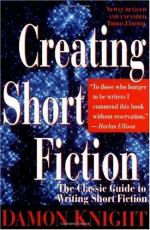
|
| Name: _________________________ | Period: ___________________ |
This test consists of 15 multiple choice questions and 5 short answer questions.
Multiple Choice Questions
1. To sell his story, of what must a writer be aware?
(a) How to edit a book entirely on his own.
(b) The market.
(c) How to talk to magazine editors.
(d) Different literary agents and their priorities.
2. Which of the following should a writer not do, according to Knight?
(a) Revise a story many times.
(b) Pay attention to the market.
(c) Avoid having an editor.
(d) Write westerns or commercial fiction.
3. Which of the following genres does Knight suggest is almost extinct?
(a) Science fiction.
(b) Western.
(c) Romance.
(d) Historical.
4. What is the purpose of reviewing work after it is complete?
(a) Making sure that the idea shines through.
(b) Finding bits to change.
(c) Finding a way to make the story shorter.
(d) Making sure the story is good.
5. Knight gives an example that sometimes a new writer relies on what part of a character to create interest?
(a) Romance.
(b) Family.
(c) Personality.
(d) Profession.
6. When is the only time that Knight says readers should not avoid writing in dialect?
(a) The character with dialect is the main character.
(b) The character with dialect is a secondary character.
(c) The writer wants to write with dialect.
(d) The writer has intimate knowledge of the speech pattern.
7. What type of market is subject to cycles and fads?
(a) Contemporary fiction.
(b) Western short stories.
(c) Commercial non-fiction.
(d) Commercial fiction.
8. What genre was once the preeminent genre?
(a) Historical non-fiction.
(b) Western.
(c) Romance.
(d) Literary fiction.
9. Which of the following is a question Knight suggests the writer must ask about 'who'?
(a) Who is the story about?
(b) Who is telling the story?
(c) Who is the reader?
(d) Who is the protagonist?
10. If a writer finds too much wrong with a manuscript when reviewing it, what does Knight suggest might have to happen?
(a) The writer seeks professional editing help.
(b) The writer sells it as is.
(c) The writer spends days on end reviewing it some more.
(d) The writer abandons it.
11. What is the advantage of the omniscient viewpoint?
(a) It allows movement between characters.
(b) It is easier for the writer.
(c) It allows the writer to show more personality.
(d) It allows a character to physically describe himself.
12. If the writer feels the story is becoming boring, what does Knight believe is necessary?
(a) Ending the story early.
(b) Making drastic cuts.
(c) Scrapping the story entirely.
(d) Starting over with the same idea.
13. If a reader already knows information that the writer is repeating, what does it become?
(a) Knowledge.
(b) Detail.
(c) Imagery.
(d) Noise.
14. What type of resolution does Knight suggest a writer needs to create?
(a) Surprising.
(b) Calm.
(c) Satisfying.
(d) Mediocre.
15. According to Knight, which point of view is the most difficult for a writer to cope with?
(a) Second.
(b) Detached.
(c) First.
(d) Third.
Short Answer Questions
1. For thousands of years, what was the only acceptable viewpoint?
2. Which of the following is not an example of a revision to a manuscript?
3. Which of the following is a reason Knight gives for an author not finishing a story?
4. What point in the book is the easiest for a writer to become "stuck"?
5. What is a consequence of not following an editor's advice?
|
This section contains 573 words (approx. 2 pages at 300 words per page) |

|




